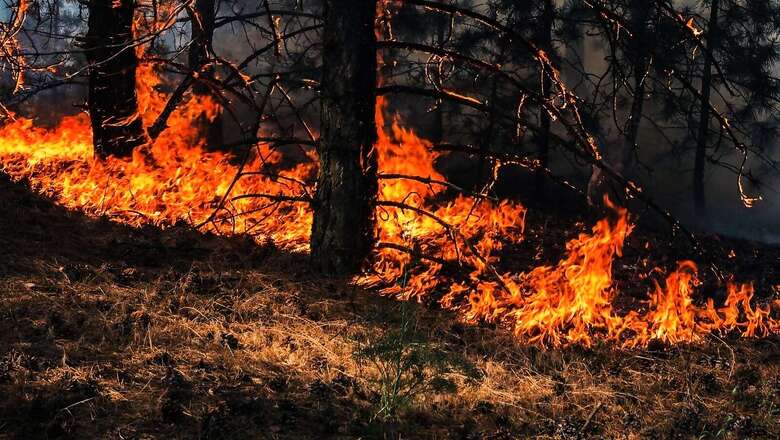
views
Forests can be both net emitters or net sinks of carbon. Parallelly, the release of carbon from forests can be due to natural processes such as oxidation and reduction, or practices such as deforestation and forest fires. Approximately 25% of global emissions come from the land sector, the second largest source of greenhouse gas emissions after the energy sector and about half of these (5-10 GtCO2e annually) comes from deforestation and forest degradation.
Besides their potential to serve as deep carbon sinks, forests help stabilise the climate. Ecosystem stabilisation, protection of critical biodiversity, and providing support to livelihoods are some of the other ways in which forests prove to be essential for our survival. Halting the loss and degradation of natural systems and promoting their restoration has the potential to contribute over one-third of the total climate change mitigation that scientists say is required by 2030, in order to meet the objectives of the Paris Agreement. India, at CoP26, has committed to reducing the country’s emissions intensity, or emissions per unit GDP, by at least 45 per cent by the year 2030 from the 2005 levels. Estimates show that nearly two billion hectares of degraded land across the world—an area the size of South America—offers opportunities for restoration. Increasing the area under forests and sustainably managing them by enhancing their productivity is, therefore, one of the key solutions towards climate change.
Climate change mitigation by leveraging forests in India
Forests react sensitively to changing climate as climate and forest are intrinsically linked by extreme climatic conditions, dynamism in biodiversity, and changing land use patterns. Land use, land-use change, and forestry sequestered 301,193 Gg of total CO2 emissions in 2014, which is about 18 percent of India’s total GHG emissions. The estimated carbon stock in the forests increased from 6,941 million tonnes in 2011 to 7,044 million tonnes in 2013, which is a net increase of 1.46% in the country’s carbon stock within two years.
As per the India State of Forest Report 2019, 712,249 sq. km, i.e., 21.67% of the geographical area of the country is covered by forests. The total carbon stock in the forests for 2019 has been estimated to be 7,124 million tonnes. The annual increase of carbon stock is worked out to be 42.6 million tonnes, which are 97.64 million tonnes of CO2 equivalent. Approximately 80% of the country’s terrestrial biodiversity exists in forests, and more than 300 million people have a high dependency on the forest for their livelihood. Besides meeting 40% energy need and 30% fodder requirement, other non-timber forest products are also provided by the forests.
Mitigation and adaptation measures are, thus, encouraged by the government through plantation, afforestation, and reforestation programmes to conserve and enhance the carbon sink. Particularly, natural climate solutions, such as land preservation and timber harvest management are viable options for avoiding greenhouse gas emissions and increasing the magnitude of the land carbon sink.
Forest productivity and climate commitments
According to the India State of Forest Report 2019, lands with canopy density less than 40% (i.e., open forests and scrub forests) cover around 10.67% of forest cover in India. India’s total emission between now and 2030 is expected to be in the range of about 40 billion tonnes. It is in this amount, that a one billion tonne reduction has been announced at CoP26. This commitment provides impetus to the two-pronged agenda of both expanding and augmenting forest cover in the country in the forthcoming decade. In this context, targeting and ensuring forest productivity can help in evaluating current forest inventory, planning bio-economy and sustainable forest management, and assessing current and future wood supply to ensure that growth, harvest, and usage can be accounted for, in the carbon cycles, and even contribute towards addressing NDCs and other climate commitments.
Context of CoP26 and possibilities for the future
As conversations at CoP26 lead to serious commitments towards reducing carbon emissions and meeting climate targets, the crunch of carbon finance in the Covid-slowed economic era is making the scenario all the more challenging. Two instrumental interventions have the potential of translating these policy deliberations into critical action. Firstly, there is a need to analyse the importance and relevance of the REDD+ mechanism in the context of the new agenda of climate deliberations viz stricter enforcement of NDCs and the commitments undertaken under the Paris agreement by the laying down of specific, tangible rules and procedures to meet the targets objectively and timely. Secondly, by adapting net zero or carbon neutrality targets for the future, backed by both ambition and funding roadmaps, nations can take on the challenge of making strides towards a sustainable world.
Condensing the commitments and stricter compliance mechanisms are going to force countries to take a mix of measures depending on their developmental priorities keeping in view their socio-economic aspirations. Therefore, in such a situation, developing countries would have options for reducing emissions—one, by adopting cleaner technologies and two, by offsetting their carbon emissions in the form of carbon sequestration. Since many of the developing countries either do not have scope, or have very limited scope, of further enhancing carbon sequestration by reducing deforestation and increasing green cover, the possibility of looking into carbon crediting and carbon offsetting for meeting their carbon reduction targets will be an emerging solution. This, in turn, will invigorate the carbon markets leading to refreshing the demand for carbon credits and carbon offsets, especially for developing countries such as India and get the gears going towards stronger and better climate action. In this regard, an ecosystem for the carbon markets, with both private and public players as stakeholders, can not only give a fillip to the mechanism but also enable sharing of benefits with communities involved in protecting forests and carrying out plantations on their land. Public-oriented approaches towards the harvesting of plantations or trees grown outside forests, mostly on private lands, can also provide impetus to greater afforestation and plantation activities by common people on their land. This will also reduce the import of timber by the country, cater to the domestic demand, and create alternative livelihoods for farmers and entrepreneurs.
In such an emerging scenario, forests and tree cover can be leveraged in a proactive manner by developing countries like India to boost their climate action compliances and support the global climate mitigation efforts.
The article was first published in ORF
The author is a member of the Indian Forest Service. The views expressed in this article are those of the author and do not represent the stand of this publication.
Read all the Latest Opinions here














Comments
0 comment